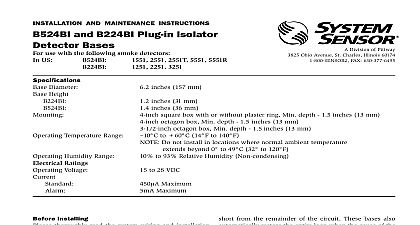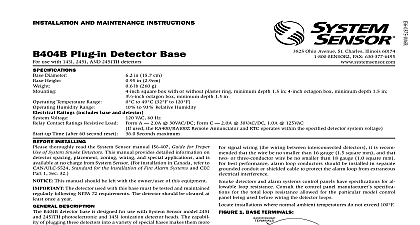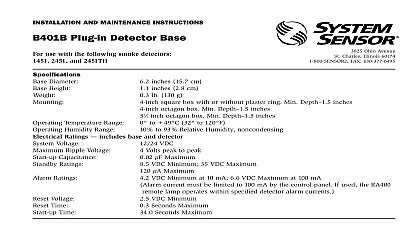System Sensor B524RB Manual

File Preview
Click below to download for free
Click below to download for free
File Data
| Name | system-sensor-b524rb-manual-5389207164.pdf |
|---|---|
| Type | |
| Size | 635.09 KB |
| Downloads |
Text Preview
A Division of Pittway 3825 Ohio Avenue St Charles Illinois 60174 FAX 630 377 6495 AND MAINTENANCE INSTRUCTIONS and B224RB A Plug in Detector Bases use with the following models For use with any 500 Series detector For use with any 200 Series detector inches 157 mm Diameter Height Temperature Range Humidity Range Ratings Voltage Averaged Standby Ratings 500 24 VDC Characteristics to 28 VDC coil latching Form C Type Relay Time Time A 30 VDC A 110 VDC with 35 PF or greater A 120 VAC with 35 PF or greater A 30 VDC with 6 PF or greater seconds minimum 20 seconds maximum second minimum 8 seconds maximum inches 31 mm inches 36 mm square box with or without plaster ring Min Depth 1.5 inches 13 mm octagon box Min depth 1.5 inches 13 mm octagon box Min depth 1.5 inches 13 mm to 49 C 32 to 120 F to 93 Relative Humidity Non condensing Installing thoroughly read the system wiring and installation and manual I56 407 Guide for Proper Use of Sys Smoke Detectors which provides detailed information detector spacing placement zoning and special appli Copies of these manuals are available at no charge System Sensor For installation in Canada refer to Standard for the Installation for Fire Alarm and CEC Part 1 Sec 32 This manual should be left with the owner user this equipment The detector used with these bases must be and maintained regularly following NFPA 72 require The detectors should be cleaned at least once a year Information C latching relay contacts are included for the control an auxiliary function The relay operates 12 seconds after activation of the sensor head remote an output detector base mounts directly to 31 2 and 4 inch oc and 4 inch square boxes with or without a plaster mount remove the decorative ring by rotating it in ei direction to unhook the snaps Then separate the ring the base Install the base on the box using the screws with the junction box and the appropriate slots in base Replace the decorative ring on the base and ro it in either direction until the ring snaps in place see 1 Guidelines wiring must be installed in compliance with all appli local codes and any special requirements of the local having jurisdiction using the proper wire sizes conductors used to connect smoke detectors to control and accessory devices should be color coded to re the likelihood of wiring errors Improper connections prevent a system from responding properly in the event a fire signal wiring the wiring between interconnected de it is recommended that the wire be no smaller 18 gauge 1.0 square mm However wire sizes up to gauge 3.3 square mm can be used with the base The of twisted pair wiring or shielded cable for the power and loop is recommended to minimize the effects of interference shielded cable is used the shield connection to and from detector must be continuous by using wire nuts crimp or soldering as appropriate for a reliable connection system control panels have specifications for allow loop resistance Consult the control panel specifica for the total loop resistance allowed before wiring the loops Instructions base uses a latching relay that can change states if it is to mechanical shocks or jarring As a result even relay contacts are in the open state when the base is from the factory the contacts may have closed shipment an auxiliary control circuit to closed relay con can cause an unexpected and possibly dangerous ac of that circuit Therefore do NOT connect an control circuit to the relay contacts terminals 1 and 3 before ensuring that the relay contacts are in their state Ensure that the contacts are open by applying to the bases WITHOUT the sensor heads installed wiring connections by stripping about 3 8 10 mm insulation from the end of the wire Then slide the wire the clamping plate and tighten the clamping plate 1 Mounting the base to an electrical box ON NOT NOT the normally open NO line to terminal 2 see Figure Insert the normally closed NC line of the relay to ter 1 and the relay common line to terminal 3 Wire the lines in and out to terminal 4 In the communication line in and out to terminal Terminal 6 is for shielded cable only see Figure 2 If cable is used the shield connection to and from detector must be continuous by using wire nuts or soldering to ensure a reliable connection If cable is not used leave terminal 6 in the screwed position the zone wiring of all bases in the system before in detector heads This includes checking the wiring continuity correct polarity ground fault testing and a dielectric test 2 Wiring diagram PAIR RECOMMENDED INTELLIGENT RELAY COMMON NORMALLY CLOSED NORMALLY OPEN A OPTIONAL WIRING label is affixed to the base for recording the zone ad and type of detector being installed at the base loca This information is useful for setting the detector head and for verification of the sensor type required for location all detector bases have been wired and mounted and loop wiring has been checked the detector heads may installed in the bases Feature Do not use the tamper resist feature if the removal is to be used detector base includes a tamper resist feature that pre its removal from the base without the use of a tool activate this feature break the tab from the detector as shown in Figure 3A see page 4 Then install the remove the detector from the base once the tamper re feature has been activated insert a small bladed screw into the slot in the side of the base and push the lever away from the detector head see Figure 3B 4 This allows the detector to be rotated counter for removal Head removal after the tamper resist feature has activated first requires removal of the decora ring tamper resist feature can be defeated by breaking and the plastic lever from the base However this pre the feature from being used again 3A Activating the tamper resist feature 3B Removing the detector head from the LEVER TAB AT LINE BY TOWARD OF BASE SMALL BLADED TO PLASTIC LEVER DIRECTION OF Limitations of Property Protection Smoke Detectors smoke detector used with this base is designed to activate and ini emergency action but will do so only when it is used in conjunction an authorized fire alarm system This detector must be installed in with NFPA standard 72 detectors will not work without power AC or DC powered detectors will not work if the power supply is cut off detectors will not sense fires which start where smoke does not the detectors Smoldering fires typically do not generate a lot of which is needed to drive the smoke up to the ceiling where the detector is usually located For this reason there may be large de in detecting a smoldering fire with either an ionization type detector a photoelectric type detector Either one of them may alarm only after has initiated which will generate the heat needed to drive the to the ceiling from fires in chimneys in walls on roofs or on the other side of a door s may not reach the smoke detector and alarm it A detector detect a fire developing on another level of a building quickly or at For these reasons detectors shall be located on every level and in bedroom within a building detectors have sensing limitations too Ionization detectors and detectors are required to pass fire tests of the flaming and type This is to ensure that both can detect a wide range of of fires Ionization detectors offer a broad ran


